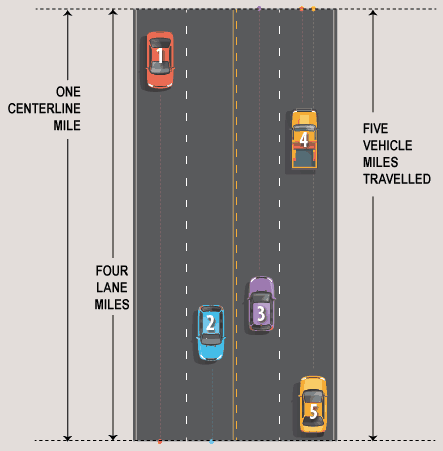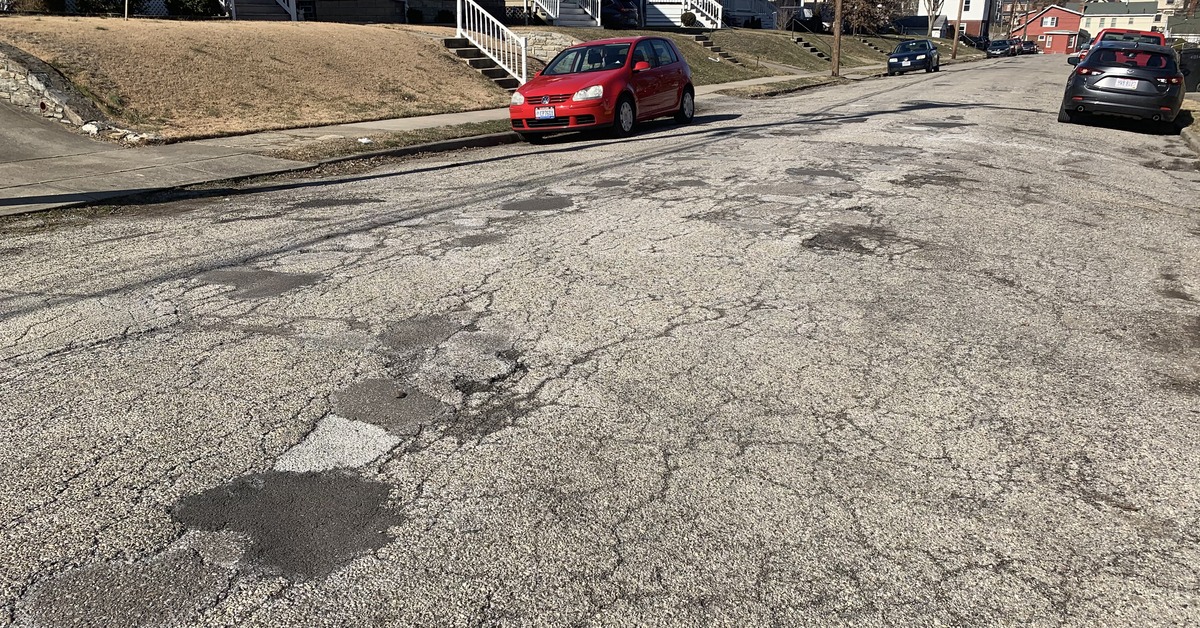In some parts of the country, people make small talk by bringing up the weather or the local sports team. In Norwood, Ohio, we make small talk about the roads, and everyone has an opinion.
It’s no secret that the situation is a mess, but sometimes I think it’s such a big mess that it’s hard to even have rational conversations about it. We hear:
- If so-and-so gets elected, they’re going to fix the roads; or…
- If only we spent less money on such-and-such department, we’d have enough money to pave the streets.
Well, neighbor, I’m sorry to tell you that there’s no easy solution. But in order to bring some more clarity to the situation, I undertook the following exercise. What follows is one man’s attempt to answer the question, “how much will it cost to fix Norwood’s roads?“
A Brief History of Street Projects in Norwood
Between 2017 and 2020, the City has spent $4,448,615 to carry out eight different improvement projects spanning 5.18 lane miles of road. I know this by looking at the auditor’s site and other publicly circulated documents.
So that there’s less confusion about the terms I’m going to use, here is a graphic that shows the difference between centerline miles, lane miles, and vehicle miles traveled. This will come in hand later.

To explain the picture… if a stretch of Montgomery Road is one mile long and has two lanes in each direction (four lanes total), it would have a centerline length of one mile, and be comprised of four lane miles.
The good news is that we’ve improved 5.18 lane miles of roads in the past four years.
The bad news is that there are 142 lane miles of roads in Norwood.
There are probably lots of fancy ways to figure out how much our roads are going to cost — like hiring a firm and paying them to do a survey — but for simplicity sake, I’m going to look at how much we’ve spent to improve those 5.18 lane miles and then figure out a cost/lane mile dollar amount. From there, we can multiple 142 lane miles times the cost per lane mile and come up with a total.
Not all road projects are created equal
In reviewing the eight projects that have happened since 2017, I quickly hit a sticking point. There is one batch of improvements that cost between $195,000 and $375,000 per lane mile, and then there’s another batch that cost between $1.6M and $2.6M per lane mile. That’s a huge discrepency.
Upon further examination, though, it turns out that some of the projects have been resurfacing, while others have been total rebuilds.
Here’s a look at the resurface projects, which are more surface-level (cosmetic) in nature and deal mainly with the driving surface.

Across these projects, we spent a little over a million dollars to resurface just under 3.4 lane miles of road. That puts our resurfacing cost per lane mile at $296,519.
On the other hand, there have been a number of rebuild projects that require much more comprehensive work. Think about it like the difference between re-tiling your shower area vs. knocking out a wall, framing out a new wall, putting up backer board, and then re-tiling the shower. These rebuild projects are much more intensive.

Naturally, rebuild projects are much more expensive, coming it at a per-lane-mile cost of nearly $2 million. This includes work like rebuilding the curbs, re-doing the sewer basins, and things of that nature.
What are the odds?
We’re getting closer to a conclusion now that we know:
- There are 142 lane miles of road in Norwood
- It costs about $296,000 per lane mile of resurfacing work
- It costs about $1.9M per lane mile of rebuilding work
The last piece of the equation, then, is to try to figure out how many of our 142 miles need rebuilt and how many only need resurfacing. Is it 50% of roads? Is it 20% of roads. Honestly, your guess is as good as mine.
To test some different scenarios, I put together the following table, which shows (in green) the cost of the lane miles that need rebuilt and (in blue) the cost of the lane miles that need resurfaced. All the way on the right, you see the total estimated cost to fix Norwood’s roads for each scenario.

Thinking about your street and the ones around it, how many need rebuilt? How many need resurfaced? Thinking about the roads I frequent, I’d lean toward one in four (25%) needing rebuilt. So, for me, I’d probably adopt the $100,000,000 price tag as the one that feels true to me. You read that right — one hundred million dollars.
And, for what it’s worth, that doesn’t even account for the rising cost of labor and materials. There’s a time-value-of-money element at play here that will drive the price higher than whatever scenario you embrace. But that’s another level of complexity that I don’t care to add this morning. The point is: we’re talking about a huge number!
What now?
Unfortunately — as I wrote about in how a city goes bankrupt — the property taxes from the houses on any given street don’t generate enough revenue to pay for the maintenance on that street. So, that money has to come from somewhere else.
Meanwhile, the city’s other big driver of revenue — Income Tax — which brings in about $17M a year to the general fund, is immediately offset by the ~$15M we spend annually on police, fire, public buildings and (up until recently) dispatch. The other ~$2M goes to the Health Dept, Tax Dept, Parks, and other city departments.
According to the Ohio Auditor, municipalities should be on a plan that allows for every city road to be resurfaced at least once every 15 years. That would mean that Norwood should be spending $6.6M annually ($100M/15) on road improvements. Mind you, that’s $6.6M of a $23M annual budget.
In reality, we’ve only been spending about $1.1M per year between 2017 and 2020.
Closing the gap
So, we need to spend about $6.6M per year in roads and we’re only spending $1.1M annually. Where does that other $5.5M come from? Here are a few thoughts. We could…
- Get more competitive contractors to do this work, which could bring the price down… but then again, the people who got this work won it through a bidding process, so there’s probably not a lot of cost-savings to be had there.
- Do more projects at once, and do them geographically-closer together, which would allow us to benefit from economies of scale.
- Seek grant money available through state and federal governments that could help. Finding those monies is probably a good use of city employees’ time.
- Reduce the number of lane miles we have in service through a road diet… but few of Norwood’s roads are wider than 30 feet, so there’s probably not more than 5-10 percent savings here.
- Buy our own machinery and hire more public works employees, then do everything ourselves. That would probably be more cost-efficient in some ways, but would also incur new costs in the form of machinery and its maintenance, plus the salaries and benefits of those additional employees.
- Levy a tax that would run for a fixed period of time — say 15 years — that would allow us to modernize every road in the city between now and 2037… but then what’s the permanent funding source beyond 2037? By the way, in the 2020 Community Survey I did, a significant portion of the 200+ respondents favored a street levy. More to come on that in the next week or two.
In closing
To make a long story short, this is an expensive, complicated matter to resolve. And no political candidate or party can get us there. It’s going to take creative thinking, and sacrifices from residents and city departments.
Given our financial situation, we can have some things, but not everything. The city has been mismanaged for too long for us to all the sudden have our cake and eat it too. So, how badly do you want road improvements?
Are you willing to reduce the size of our police and fire departments in order to have better driving surfaces? Or do you like police and fire as they are?
Are you willing to outsource our Emergency Dispatch operation to the Hamilton County Communications Center? Or is Dispatch such a vital part of our identity that we have to keep those costs on our books?
Do you love being a Statutory City — which requires we use a boilerplate set of laws from the state of Ohio, including municipal funding mechanisms — or are you willing to roll up your sleeves and help us pursue a custom charter for the city of Norwood?
There are no easy solutions, only compromises. And, if we are ever going to get there, we’ve got to learn to make compromises in a massive, communicative, and collaborative way.
—
Move Norwood Forward aims to shed light on the people, businesses and happenings of Norwood, Ohio that are working to better the city. If you know of a person who should be featured on an episode, nominate them here.


No easy answers – initial big out lay but as Norwood roads are so far behind having an internal city road unit would make the most sense for at least a 10-15 year time span and farm out the crew to for profit venture w/St Bernard/golf manor/Amberly/Lockland roads once Norwood roads are restored. Plus do roads not as minimal grade but optimal. As is most repaved roads go from black to grey after 2 years and greyish white after 5 years then cracks/potholes. Use sufficient emulsion. Norway gets harsh winters – yet their road are always immaculate, smooth, black.